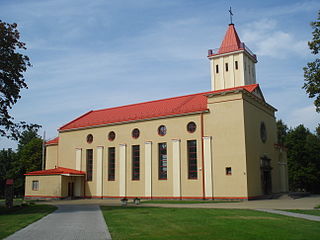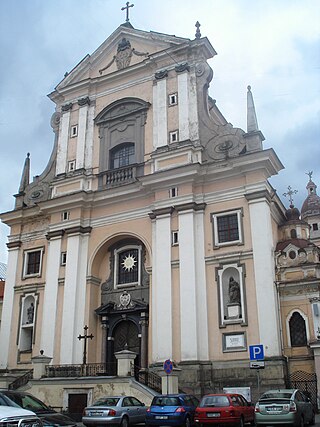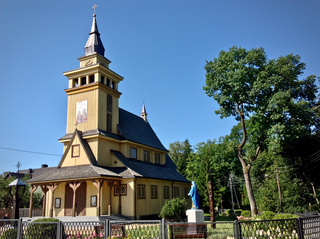68 Sights in Vilnius, Lithuania (with Map and Images)
Legend
Premium Sights
Book tickets, guided tours and activities in Vilnius.
Guided Free Walking Tours
Book free guided walking tours in Vilnius.
Welcome to your journey through the most beautiful sights in Vilnius, Lithuania! Whether you want to discover the city's historical treasures or experience its modern highlights, you'll find everything your heart desires here. Be inspired by our selection and plan your unforgettable adventure in Vilnius. Dive into the diversity of this fascinating city and discover everything it has to offer.
Sightseeing Tours in VilniusActivities in VilniusVilnius st. The Church of Ona is a Catholic church called st. In the name of Ona, standing in the Old Town of Vilnius, on the left bank of Vilnia. It was built between 1495 and 1501 and burned more than once, rebuilt, renovated, reconstructed and restored. St. The ensemble of Ona and Bernardinai churches is the most famous Gothic monument in Lithuania, which was included in the Register of Cultural Values of the Republic of Lithuania in 1992.
Gediminas' Tower is the remaining part of the Upper Castle on top of the Gediminas Hill in Vilnius, Lithuania. It has a viewing platform that offers scenic views of Vilnius Old Town and Vilnius Central Business District.
3. Gate of Dawn
The Gate of Dawn, or "Sharp Gate" is a city gate in Vilnius, the capital of Lithuania, and one of its most important religious, historical and cultural monuments. It is a major site of Catholic pilgrimage in Lithuania.
4. Palace of the Grand Dukes of Lithuania
The Palace of the Grand Dukes of Lithuania is a palace in Vilnius, Lithuania. It was originally constructed in the 15th century for the rulers of the Grand Duchy of Lithuania and the future Kings of Poland. The palace, located in the lower castle of Vilnius, evolved over the years and prospered during the 16th and mid-17th centuries. For four centuries the palace was the political, administrative and cultural centre of the Polish–Lithuanian Commonwealth. It was demolished in 1801.
Wikipedia: Palace of the Grand Dukes of Lithuania (EN), Website
5. Icon of Our Lady of the Gate of Dawn
Our Lady of the Gate of Dawn is the prominent Christian icon of the Blessed Virgin Mary venerated by the faithful in the Chapel of the Gate of Dawn in Vilnius, Lithuania. The painting was historically displayed above the Vilnius city gate; city gates of the time often contained religious artifacts intended to ward off attacks and bless passing travelers.
6. The Hill of the Three Crosses
Three Crosses is a prominent monument in Vilnius, Lithuania, on the Hill of Three Crosses, originally known as the Bald Hill, in Kalnai Park. According to a legend, which finds its source in some historic events, seven Franciscan friars were beheaded on top of this hill. Wooden crosses have been sited in the location since the early 17th century, and they became a symbol of the city and an integral part of the city's skyline.
7. Tuskulėnai Manor Palace
Tuskulėnai Manor is a neoclassical manor in Žirmūnai elderate of Vilnius, Lithuania. It is best known as burial grounds of people executed by the KGB in 1944–1947. After Lithuania regained independence in 1990, the manor was reconstructed and the park was transformed into a memorial to the victims of Soviet repressions. It is administered by the Lithuanian Genocide and Resistance Research Center.
8. Vienybės medis
The Unity Tree is a stone sculpture unveiled on 7 July 2009 in Vilnius' Vingis Park, celebrating the thousandth anniversary of the name of Lithuania. The authors of the sculpture are sculptor Tadas Gutauskas and architect Rolandas Palekas.
9. MO Museum
The MO Museum is a modern art museum in Vilnius, Lithuania. As a private initiative of Lithuanian scientists and philanthropists Danguolė Butkienė and Viktoras Butkus, it functioned as an art museum without walls for about ten years. The collection of 6,000 modern and contemporary pieces contains major Lithuanian artworks from the 1950s to the present day.
10. Lithuanian National Drama Theatre
Lithuanian National Drama Theatre, located on Gediminas Avenue in Vilnius, is one of Lithuania's most prominent publicly funded performing arts venues and cultural institutions. Founded as a Vilnius State Theatre in 1940, it became Lithuanian National Drama Theatre in 1998. The theatre's façade featuring the Feast of Muses sculpture by Stanislovas Kuzma has become a landmark of Vilnius city.
11. Sapiegų rūmai
Sapieha Palace is a High Baroque palace in Sapiegos str., Antakalnis district of Vilnius, Lithuania. It is the only surviving of several palaces formerly belonging to the Sapieha family in the city. The palace is surrounded by the remains of the 17th-century formal park, with parterres, ponds, and avenues. The impressive Baroque gate secures the entrance to the park from Antakalnis street and the other gate is on the opposite side of the park, near the palace. Both of them were restored in 2012.
12. The Former Detention House
The National Museum of Lithuania, established in 1952, is a state-sponsored historical museum that encompasses several significant structures and a wide collection of written materials and artifacts. It also organizes archeological digs in Lithuania.
13. Bank of Lithuania Money Museum
The Money Museum of the Bank of Lithuania is a Lithuanian museum that is familiar with the history of world and Lithuanian money. It was established in the palace complex of the Bank of Lithuania on Gediminas Avenue in Vilnius.
14. House of the Signatories
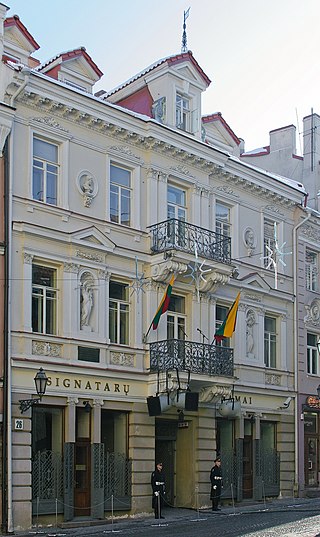
The House of the Signatories is a Lithuanian historic landmark on Pilies Street, Vilnius, where on February 16, 1918, the Act of Independence of Lithuania was signed by twenty members of the Council of Lithuania.
15. Vilniaus Šv. Konstantino ir Michailo cerkvė
The Orthodox Church of St. Michael and St. Constantine is a Russian Orthodox church in Vilnius, Lithuania, belonging to the Russian Orthodox Diocese of Lithuania.. It was built in 1913 to commemorate the 300th anniversary of the Romanov dynasty. It was built by I. Kolesnikov, and incorporates the Rostov and Suzdal architectural styles. On its consecration day of May 13, the church was visited by the former royal figure Grand-Duchess Elizabeth Feodorovna. She was known at the time of consecration as Sister Elizaveta and is now a martyr within the Russian Orthodox Church.
16. All Saints Church
All Saints Church is a Baroque-style church in Vilnius, Lithuania. All Saints church was built between 1620 and 1630 and was adopted for Carmelites' needs. In the second half of the 17th century, the church was linked with a monastery and formed a single complex.
17. Orthodox Church of the Holy Spirit
The Orthodox Church of the Holy Spirit is a Russian Orthodox church in the Vilnius Old Town, capital of Lithuania, rebuilt 1749–1753 in the Vilnian Baroque style. The monastery serves as the headquarters of the Russian Orthodox Diocese of Lithuania. It should not be confused with the Roman Catholic Church of the Holy Spirit in Vilnius.
18. Choral Synagogue, Vilnius
The Choral Synagogue of Vilnius, officially, Taharat Ha-Kodesh Choral Synagogue in Vilnius, is an Orthodox Jewish congregation and synagogue, located at 39 Pylimo Street, in the Old Town of Vilnius, in the Vilnius County of Lithuania.
19. Vilniaus senasis teatras
Old Theatre of Vilnius, built in 1913 as Pohulanka Theatre and formerly known as Russian Drama Theatre of Lithuania and other names, is a theatre in the Old Town of Vilnius. It is the only professional theatre in Lithuania that stages performances in Russian.
20. Energetikos ir technikos muziejus
Energy and Technology Museum is an institution dedicated to researching and presenting energy history, the industrial heritage of Lithuania, and the history of Vilnius. It is housed in a former Vilnius power plant. At 5,000 square meters, this museum is the largest museum of technology in Lithuania.
21. Reformatų parkas
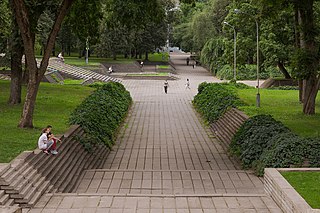
Reformatai Park – a park (square), located in the center of Vilnius city, near Pylimas Street, opposite the Vilnius Evangelical Reformed Church, was founded during the Soviet period on the site of the former evangelical reformed cemetery. Next to it is the stop of public transport "Reformatai stop". The park is administered by Všį "Vilnius City Parks".
22. Šventosios Dvasios bažnyčia
Dominican Church of the Holy Spirit, Vilnius is a church in Vilnius, Lithuania, a monument of high and late Baroque. Crowned with a cupola, it stands out in the panorama of the old town and can be seen from surrounding streets.
23. Museum of Applied Art
The Museum of Applied Arts and Design is a subdivision of the Lithuanian Art Museum, founded in 1987 in the rebuilt in 1987 by the Lower Castle of Vilnius in the XVI century. In the eastern hull of the old arsenal.
24. Vilniaus gynybinės sienos Bastėja
The bastea of the defensive wall of Vilnius is a fortification structure built in the first half of the XVII century, consisting of a tower, a cannon room and a tunnel connecting them. It is considered an integral part of the defensive wall of Vilnius.
25. Panerių skulptūrų parkas
Paneriai Sculpture Park is a concrete sculpture park in High Panerai, Vilnius, located at the intersection of the A4 Vilnius–Varėna–Grodno trunk road and Žarijų str. The park contains six concrete sculptures created during the concrete sculpture symposium "Sculpture in the Industrial Landscape", held in the autumn of 1985 - spring 1986. The initiator of the symposium is the sculptor Mindaugas Navakas, the organizers are the section of young sculptors of the Lithuanian Artists' Union and the former Vilnius large-scale house parts factory, on the territory of which a sculpture park is located. The designer of the exposition is architect Vytautas Jakubauskas.
26. Keistuolių teatras
Keistuolių Teatras is a Lithuanian theatre troupe. It was founded in 1989 by actors Ilona Balsytė, Aidas Giniotis and Sigutis Jačėnas and theatre director Romualdas Vikšraitis. The theatre produces plays and music for general public and children.
27. Automuziejus Vilnius
Automuziejus Vilnius is a museum of historical cars, located in Vilnius, in the former Taxi Park at the intersection of Darius and Girėnas and Pelesa streets. The museum operates indoors. Founded with private funds, opened on May 18, 2023.
28. Vilniaus Išganytojo bažnyčia
The Church of Jesus the Redeemer is a Roman Catholic church in the Antakalnis eldership in Vilnius, Lithuania. It was founded by the Lithuanian Grand Hetman and Voivode of Vilnius Jan Kazimierz Sapieha the Younger and the Trinitarians in 1694. Its architect is Pietro Perti, who is also the author of the nearby Church of St. Peter and St. Paul. The church, Trinitarians Monastery and the Sapieha Palace with its park formed a magnificent Baroque ensemble.
29. Vilniaus Ivano Lukievičiaus baltarusių muziejus
Vilnius Belarusian Museum named after Ivan Lutskevich - Museum in Vilnius. It is located in the building of the center of the Belarusian community and culture in Vilnius on Vilnius Street, 20. The director of the Ludwik Museum Cardis.
Wikipedia: Віленскі беларускі музей імя Івана Луцкевіча (сучасны) (BE)
30. Contemporary Art Center
Contemporary Art Centre – art institution, established in 1992 by Lithuanian Ministry of Culture. CAC has replaced the Arts Exhibition Palace and took over its building in Vilnius, 2 Vokiečių street. CAC contains five exposition rooms and a cinema hall. In 1997 FLUXUS cabinet of George Maciunas was opened, housing a permanent exhibition of fluxus artworks, assembled from private collection of Gilbert and Lila Silverman. Since 2005 CAC the periodic journal "ŠMC/CAC Interviu" is issued by CAC.
31. Pilaitės piliavietė
Pilaitė Mound, Pilaitė – a mound in Pilaitė microdistrict in Vilnius, on the left bank of the Sudervėlė stream, right next to pilaitė manor. Next to it is another mound of unknown origin, which is called the Tombs of the Crusaders, which indicates that battles with the Crusaders took place here.
32. Railway Museum
The Railway Museum is a Lithuanian museum, an institution that collects, preserves and promotes museum values related to the history of railways and their activities in Lithuania, operating in Vilnius, Geležinkelio str. 16. Director – Vitalija Lapėnienė, founder and sponsor – AB "Lietuvos geležinkeliai".
33. Šnipiškės bunkers
The Spyiškiai munitions bunker complex of the Polish army's Vilnius crew is located in Vilnius, Spyiškės, near the western edge of the intersection of Geležinis Vilkas and Žalgiris streets, at the foot of ferret hill, five ammunition bunkers. Built in the interwar period, during the occupation of Vilnius region by order of the Polish army.
34. Vilniaus Švč. Dievo Motinos Užtarėjos sentikių cerkvė
Vilnius Švč. The Church of the Old Believers of the Intercessor of Our Lady of The Intercessor is the house of worship of the old believers in Vilnius. Located in the Naujaininkai district, on a hill, where there is a cemetery of old believers.
Wikipedia: Vilniaus Švč. Dievo Motinos Užtarėjos sentikių cerkvė (LT)
35. Vilniaus Švč. Trejybės bažnyčia
Church of the Holy Trinity is a Roman Catholic church in Trinapolis, one of the parts of Lithuania's capital Vilnius. The church was built in 1715–1721 and consecrated in 1722. However, its towers were completed only in 1772.
Wikipedia: Church of the Holy Trinity in Trinapolis, Vilnius (EN)
36. Trakų Vokės koplyčia
Trakai Vokė Chapel, as well as the Chapel of the Blessed Virgin Mary, the Chapel-Mausoleum of Counts Tiškevičius – operating in the Church of the Annunciation of the Lord of Lentvaris. Parish chapel for the Virgin Mary, located in the south-west of Vilnius, in Trakai Vokė, 0.6 km north of Vilnius–Trakai road. The chapel is located in the mausoleum chapel of the former Trakai Vokė manor. An arrow of the attraction is directed to the manor. It is the chapel of the family of Counts Tiškevičiai, which stands on the outskirts of the manor house, near the southern gate to the park at the intersection of E. Andrė and J. Tiškevičius streets.
37. Aštuonių klevų ratas Vileišių sodyboje
The Maple Circle of the courtyard of P. Vileišis Palace or the Circle of Eight Maples in vileišiai homestead is an exclusive group of maples growing in Vilnius, Antakalnis, near the Petras Vileišis Palace, which was built at the beginning of the twentieth century. In the historical greenery of the urbanized area of Vilnius city, maples of extraordinary dimensions are planted in a concise circle. The circle of trees rustles near the south corner of the palace, visible from the intersection of K. Būga and Antakalnis streets.
38. Vilniaus Šv. Juozapo bažnyčia
Vilnius st. St. Joseph's Church is a newly built Catholic church in Vilnius, pilaitė microdistrict, Tolminkiemio str. 4. Vilnius st. St. Joseph's (Pilaitė) parish belongs to st. Joseph's church in Vilnius. St. Joseph's Chapel.
39. Staviškių piliakalnis
Staviškių mound, Naujoji Verkiai – a mound in the territory of Vilnius city municipality, in Staviškės, Verkiai eldership, Verkiai regional park. It is reached by verkiai street after driving almost until its end, is located on the left in the west, 250 m without reaching Goat Street, in front of the collective gardens.
40. Panerių Šv. Jėzaus Nukryžiuotojo koplyčia
St. Patrick's Church in Panthers. The Chapel of the Crucifixion of Jesus is a cemetery chapel located in the south-east of Vilnius, in Lower Paneriai, at the intersection of the A1 Vilnius–Kaunas–Klaipėda and A4 Vilnius–Varėna–Grodno roads. Accessible by leaving Vilnius by Savanorių avenue. On the hills of Paneriai, turn right at the overpass of Galvė Street. After leaving Volunteer Avenue, it's still about 120m.
Wikipedia: Panerių Šv. Jėzaus Nukryžiuotojo koplyčia (LT), Website
41. Gudeliai hillfort
Gudeliai Mound is a mound in the territory of Vilnius City Municipality, Pilaitė Eldership. It is reached by the road Salotė – Gudeliai, is located to the left north of the road turning to the right, to Gudelius.
42. Valakampių atodanga
The Valakampiai outcrop is an outcrop in the northern part of Vilnius, in the Valakampiai microdistrict, on the wooded right bank of the Neris River. The outcrop was formed almost halfway between Valakampiai Bridge and 1st Valakampiai Beach, 0.25 km south of the intersection of Vaidilutė and Nesteika streets.
43. Žemaitės skv.
Žemaitė Square is a Lithuanian square located in Vilnius, Naujamiestis, near Gediminas Avenue. Named after the writer Žemaitė (1845–1921). In the square there is a monument to Žemaitė, erected in 1971.
44. Švč. M. Marijos Ramintojos bažnyčia
Church of the Blessed Virgin Mary of Consolation is a Roman Catholic church in the Vilnius Old Town which was built by the Augustinians in 1746–1768. It is the last landmark of the Vilnian Baroque architectural style.
Wikipedia: Church of the Blessed Virgin Mary of Consolation, Vilnius (EN)
45. Crooked Hill
The Crooked Mountain is a hill in the Old Town of Vilnius, which stands 300 m east of the Castle Hill, on the left bank of the Neris River and on the right bank of Vilnia, on a high hill at the confluence of Vilnia and neris. The Crooked Castle, which was sown here, is one of the defensive castles of Vilnius. The mountain is best known for the monument of the Three Crosses erected here.
46. Tuputiškių serpantinas
Vilnius Tuputiškės Serpentine is the only cobblestone serpentine in Lithuania, built in the eastern part of Vilnius, west of Naujoji Vilnia. The raizgytas road is located in Tuputiškės, a forested section of Ring Street in Pavilniai Regional Park. The street connects The Lower Pavilnis with the High Pavilnis. Neither in length nor in height, this serpentine can not compare with mountain serpentines, but in the steepness of the bends is definitely not inferior to them. In 1997, it was added to the List of Cultural Heritage Objects. A road sign indicating the place of interest is placed next to it.
47. Šv. Juozapo a.
Hazel Owl Square – Vilnius Old Town Square. Located at the intersection of Basilian, Horse and All Saint streets. Named after the writer Hazel Owl (1867–1926). For about 100 years, until the second half of the XIX century, stood st. St. Joseph's Fiancée Church.
48. Adam Mickiewicz Memorial Apartment
The Adam Mickiewicz Museum in Vilnius is a memorial museum of the poet Adomas Mickevičius, which belongs to Vilnius University. The museum operates at Bernardinų str. 11, Vilnius, in a building that is an architectural monument of the XVII-XVIII centuries.
Wikipedia: Adomo Mickevičiaus muziejus Vilniuje (LT), Website
49. Antavilių Radziševskių koplyčia
Antaviliai Radziševskiai Chapel, or The Rose Chapel of Our Lady of The Rosary, is a brick burial chapel of former courtiers Radziševskiai, which operated in the interwar period. It is located in the northeast of Vilnius city center, in Antakalnis eldership, in Antaviliai. It is accessible by leaving Vilnius by Nemenčinė highway, about 10 km northeast of Antakalnis.
50. Švč. Mergelės Marijos Nekaltojo Prasidėjimo bažnyčia
Church of the Immaculate Conception of the Blessed Virgin Mary is a Roman Catholic church in Žvėrynas, one of the neighborhoods of Vilnius, which was for the most part completed in 1925. The initial project of the church was only partly implemented as due to the Great Depression and World War II the towers of the church were not built.
Wikipedia: Church of the Immaculate Conception of the Blessed Virgin Mary, Vilnius (EN)
51. Šv. Kryžiaus bažnyčia
Church of the Holy Cross is a Roman Catholic church in the Vilnius Old Town. Initially, in 1543 a chapel was built which was later expanded and rebuilt. The current towers were built in 1725. Following the fire in 1737 the church was reconstructed and a late baroque interior was installed.
52. Naujosios Vilnios pilkapynas
The barrow of Naujoji Vilnia is an ancient barrow in Vilnius, Rokantiškės, Pavilniai Regional Park. It is located on a hill, which lies above the Vilnia valley and A. V. Kojalavičiaus street, surrounded from the north by the Barsukynė forest.
53. Kairėnų dvaras
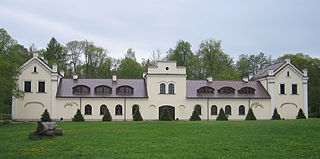
Kairėnai Manor was a residential manor in Kairėnai near Vilnius, Lithuania. Only a few buildings and park survived until nowadays. Currently its territory is occupied by the Botanical Garden of Vilnius University.
54. Vilkeliškių piliakalnis
Vilkeliškių mound, Krugla Gura – a mound in the territory of Vilnius district municipality, in Vilkeliškės, Zujūnai eldership. It is accessible from Vilnius Pilaitė district by driving west towards Kriaučiūnai, is located on the left south of the road, only after passing between baltis and Gilužis lakes.
55. Vilniaus Viešpaties Dangun Žengimo bažnyčia
Church of the Ascension is a Roman Catholic church in the Vilnius Old Town. Its construction began in 1695, but due to the lack of funding it was completed only after 35 years in 1730 and in the same year was it was consecrated as Church of the Ascension.
56. Kučkuriškių piliakalnis
Kučkuriškės Mound or Naujoji Vilnia Mound, Barsukynė Hill – a mound in Vilnius, Naujoji Vilnia eldership, Kučkuriškės, surrounded from the south by vilnia valley. It is located in pavilniai regional park, Ancučiai landscape reserve, hilly surface.
57. Reformed Church
Evangelical Reformed Church is a Continental Reformed Protestantic church in the Vilnius Old Town which was built in 1830–1835 according to a project of Karol Podczaszyński. In 2008 a new organ was installed in the church.
58. Vilniaus Dievo Apvaizdos bažnyčia
Church of the Providence of God is a Roman Catholic church in Vilkpėdė, one of the neighborhoods of Vilnius, which was completed in 1913 according to a Gothic Revival architecture style project by Antoni Wiwulski.
59. St. Johns' Church
Vilnius st. St. John the Baptist and St. John the Baptist. The Church of St. John the Apostle and Evangelist stands in the Old Town of Vilnius, on the territory of Vilnius University. Has Gothic, Baroque and classicist features. Mass is held in Lithuanian. The bell tower of the church (1610) is the tallest building in the Old Town of Vilnius, it is equipped with the Fuko pendulum, which proves that the Earth rotates around the axis.
Wikipedia: Vilniaus Šv. Jono Krikštytojo ir Šv. Jono apaštalo ir evangelisto bažnyčia (LT)
60. Cathedral Basilica of St Stanislaus and St Vladislav

Vilnius st. bishop Stanislaus and st. The Basilica of the Archdiocese of Vladislav is the most important Catholic church in Lithuania and the most significant example of classicism architecture in the country. The place of Catholic pilgrimage in the Archdiocese of Vilnius.
Wikipedia: Vilniaus Šv. Stanislovo ir Šv. Vladislovo arkikatedra bazilika (LT)
61. Panerių geležinkelio tunelis
The Paneriai railway tunnel is one of the two railway tunnels in Lithuania. Excavated under the hills in the Paneriai forest, Vilnius. The height of the tunnel is 6.4 m, width – 8 m, length – 427 m.
62. Church of St. Francis
Vilnius st. The church of Francis of Assisi stands in the Old Town of Vilnius, on the left bank of Vilnia near the Sereikiškės Park, traditionally called the Bernardinai Garden. Belongs to the Bernardines. Mass is held in Lithuanian, Latin and English.
63. Vilniaus (Kalvarijų) Šv. Kryžiaus Atradimo bažnyčia
Calvary St. The Church of the Cross is a church that stands in the Jerusalem of Vilnius, on the right bank of the Neris River. In the late Baroque style. It enters the territory of the Verkiai Regional Park. Mass is held in Lithuanian and Polish.
Wikipedia: Vilniaus (Kalvarijų) Šv. Kryžiaus Atradimo bažnyčia (LT), Website
64. Švč. M. Marijos, Taikos Karalienės bažnyčia
Blessed. The Church of the Virgin Mary Queen of Peace is a church that stands in the east of Vilnius, in Naujoji Vilnia, near the New Vilnia Stadium. Belongs to the Deanery of Naujoji Vilnia, Archdiocese of Vilnius. Holy Mass is held in Lithuanian, Russian and Polish. In the churchyard of the church there are stations of the mysteries of the rosary. Next to the church stands the parish house-rectory. The parish has a Chapel of Ghosts.
65. Šv. Teresės bažnyčia
Vilnius st. St. Teresa's Church is a church that stands in the southern part of Vilnius Old Town near the Gates of Dawn. In front of the church there is a site of an irregular quadrangle, from the north and northeast is bounded by the buildings and fence of the Orthodox Monastery of St. Spirit. The church in the style of late Renaissance, Baroque and late classicism.
66. Šv. diakono Stepono bažnyčia
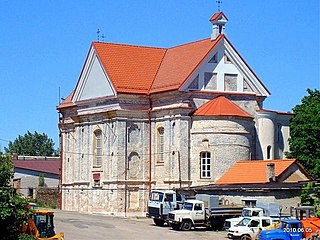
Vilnius st. St. Stephen's Church is a former church in Vilnius, station district, Geležinkelio str. 41. The church was built renaissance, reconstructed during the period of classicism. Under the layer of plaster, a partially preserved unique wall painting of friezes was unveiled. The church is located in the courtyard of the warehouses, which is difficult to get to. The facades of the church have been restored, fragments of sgraphite have been restored.
67. Pavilnio Kristaus Karaliaus ir Šv. Kūdikėlio Jėzaus Teresės bažnyčia
St. John the King of Pavilnis and St. John the Baptist. The church of the infant Jesus Teresa is a church that stands in the eastern part of Vilnius, in the High Pavilion. Services are held in Lithuanian and Polish. The only wooden Catholic church in Vilnius.
Wikipedia: Vilniaus (Pavilnio) Kristaus Karaliaus ir Šv. Kūdikėlio Jėzaus bažnyčia (LT)
68. Šv. Mikalojaus Stebukladario cerkvė
Vilnius Lukiškiai prison st. St. Nicholas' Church is located in Vilnius in Lukiškės. Built with the prison in 1904. Belonged to the Orthodox. Since 2023, believers of the Universal (Constantinople) Patriarchate have been praying there on Sundays.
Wikipedia: Vilniaus Lukiškių kalėjimo Šv. Nikolajaus cerkvė (LT), Website
Share
Disclaimer Please be aware of your surroundings and do not enter private property. We are not liable for any damages that occur during the tours.
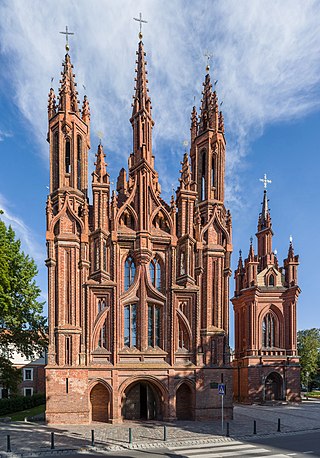
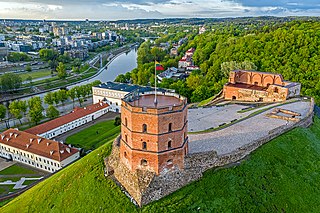
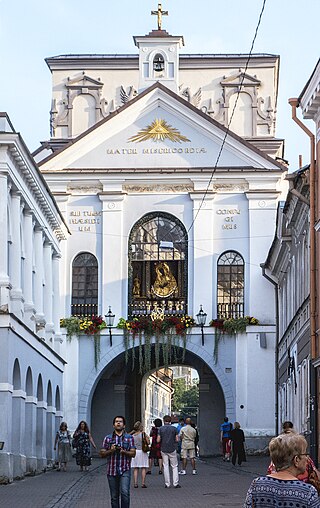
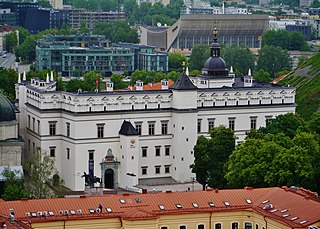
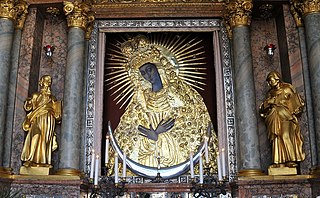

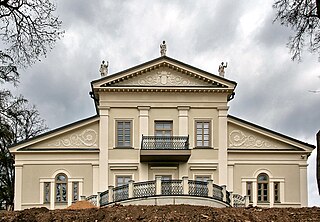
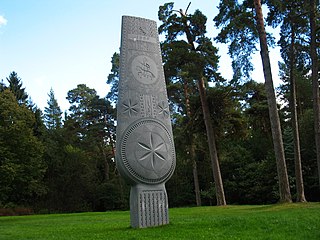

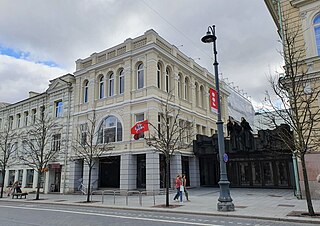

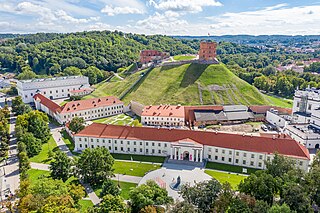


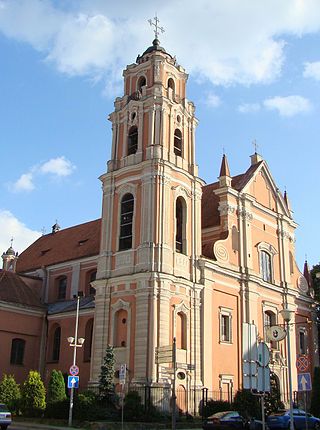
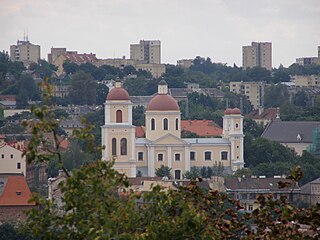
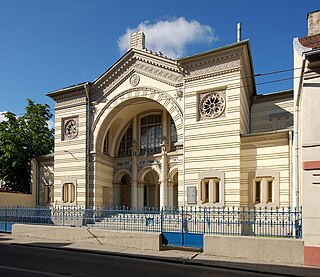
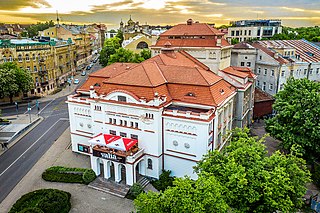

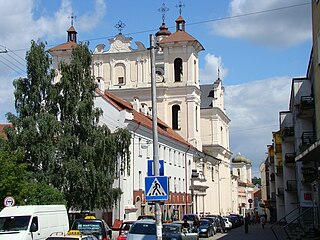
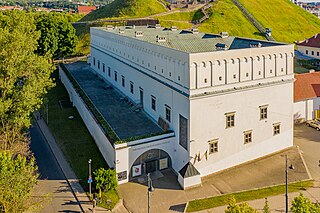
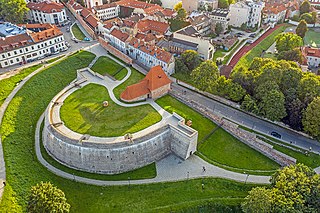


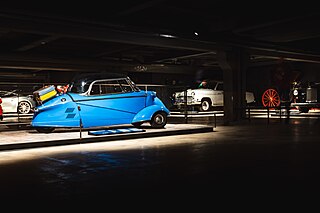
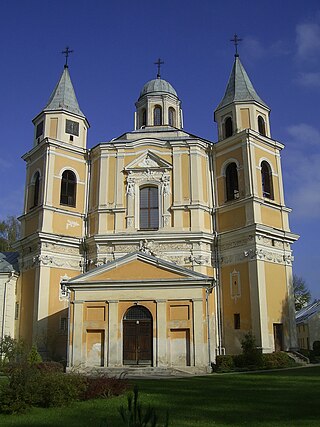

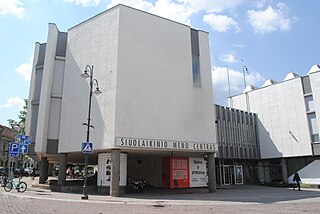


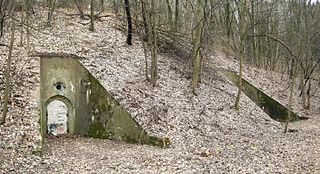


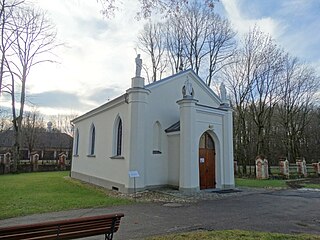

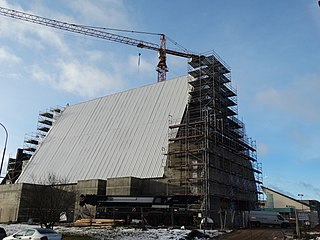
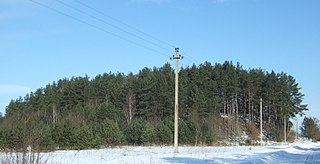
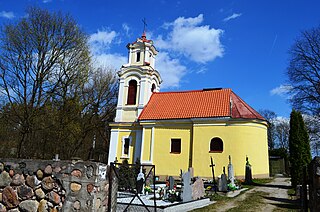
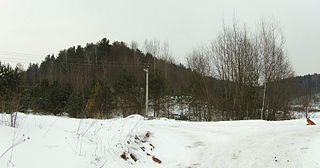


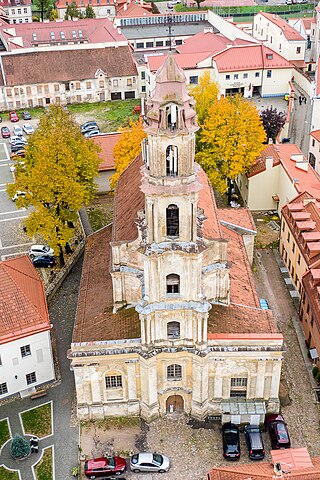
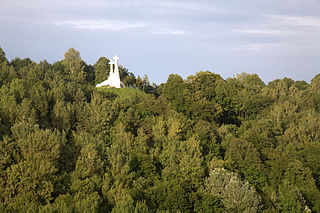
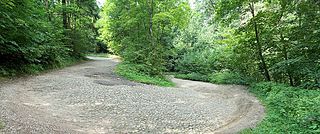
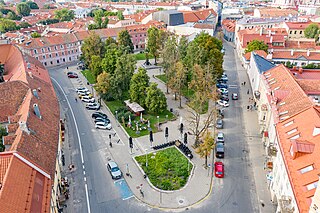
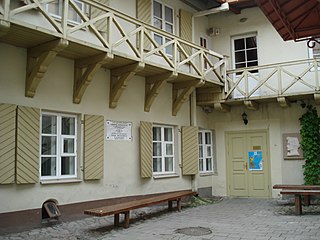

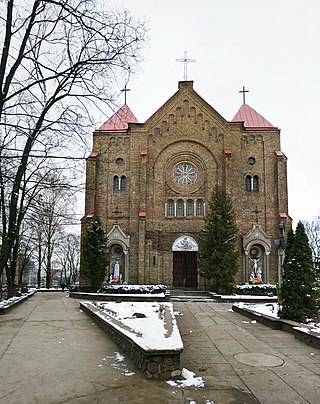
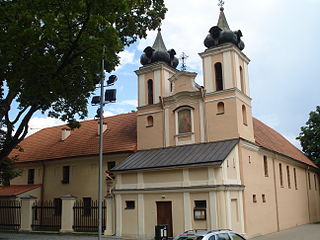
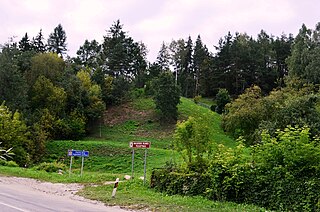

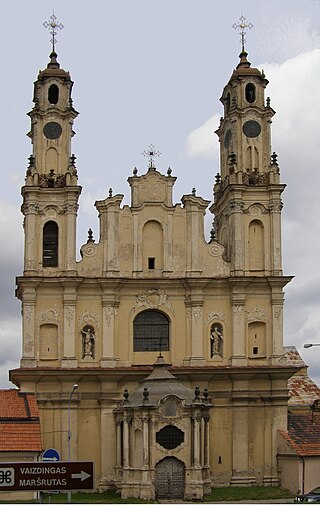
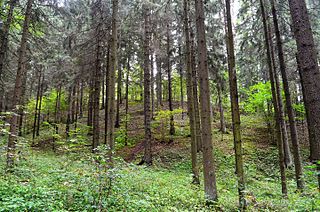
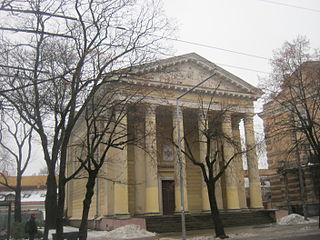
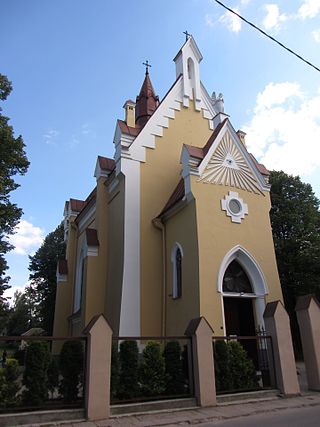

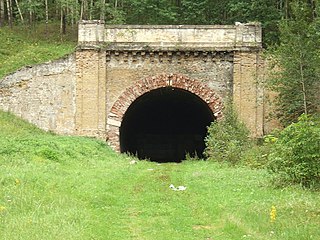

-Šv.-Kryžiaus-Atradimo-bažnyčia.jpg)
